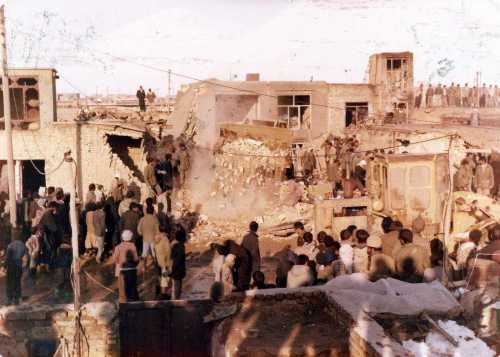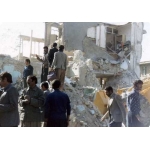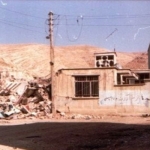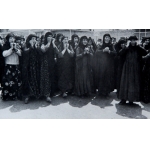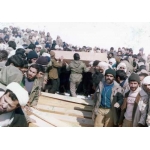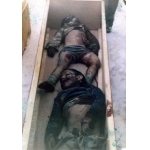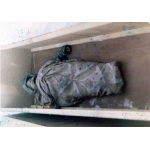Islamabad-e-Gharb
Priya Sabzmohammadi
499 بازدید
Islamabad-e-Gharb is a city in Kermanshah Province, western Iran. It was a city that was repeatedly targeted by Iraqi missiles and planes during the eight year Iraq-Iran War, thus earning the nickname “the Dezful of Western Iran.”
It is the second most populated city in the province after Kermanshah. It is also known as the “capital of Iran's oak forests[1].”
Islamabad-e-Gharb is situated between the cities of Dalahou and Kermanshah to the north, Kermanshah to the east, Gilan-e-Gharb to the west, and Ilam Province to the south. It consists of two central parts and Hamil, as well as seven villages.[2].
Dating back 3,500 years, Islamabad-e-Gharb has a rich history . According to excavations carried out in 1970 by Mahmoud Kordvani, some floral inscriptions in Babylonian script were discovered. These were then dated by Dr. Kamyar Abdi, a professor at the University of Chicago, US.[3] In 1935, the name of this city was changed from Mandali to Shahabad-e-Gharb (commonly known as Shabad)[4] and then to Islamabad-e-Gharb in 1978.[5]
Its inhabitants are primary from Kurdish tribes and different tribes of the Kalhor tribe. They speak Kurdish and adhere to Islam. The most important historical monuments of Islamabad-e-Gharb are Chaghagavaneh Hill and Shah Abbasi Caravanserai.[6]
The city serves as the center of Islamabad-e-Gharb County, located south of Kermanshah. It is connected to Kermanshah-Qasr Shirin-Khosravi Road and has another road leading east to the main Tehran-Khorramshahr route at Pol-e-Dokhtar.[7] Additionally, the Allah Akbar Garrison is located in the west of the city.[8]
During the Iran-Iraq war, areas Islamabad-e-Gharb were attacked by Iraqi infiltrators on April 15, 1980.[9] These operations continued along the border cities of Iran until, on April 20, a part of the city’s sugar factory was destroyed by Iraqi bombs, while parts of a mosque were destroyed by RPG 7 bullets.[10]
In May, Iraq fired four RPG bullets at a clinic in the village of Sheikh Mustafa in Kuzran, Islamabad.[11]
With the continuation of the Iraqi border attacks and their invasion of border cities, such as Qasr-e Shirin, Khosravi, Mehran, and Dehloran in September 1980, half the population of these cities and surrounding settlements went to Islamabad-e-Gharb.[12]
With the commencement of the war by Iraq on September 22, 1980, Islamabad was bombed by Iraq, killing and wounding several people.[13]
An emergency landing strip, 4500 meters long, was created southeast of Islamabad and south of the Islamabad-Kermanshah-Pol-e-Dokhtar Highway.[14]
Four Iraqi MiGs attacked Islamabad on October 11, one of the MiGs was shot down.[15] The next airstrike was on June 5, 1981, when two Iraqi MiGs attacked the village of Sheikh.[16]
About a year later, in late July 1982, Iraqi planes repeatedly attacked the western airspace of Islamabad, firing on the defense positions of the Islamic Republic of Iran.[17]
In the summer of 1983, the Iraqi army, aware of Iran's plans to conduct operations in the area in front of the cities of Baneh to Marivan, put various measures in place to prevent its implementation. In a radio message to the people on September 1, 1983, the Iraqis set this day as the deadline for them to evacuate Islamabad and threatened them with bombing. These measures were taken to prevent Operation Fajr 4, which was carried out on October 23, 1983.[18]
During the war, repeated bombings left the city insecure and deserted, with many of its inhabitants fleeing to surrounding villages. They began returning home from October 1983.[19]
On October 28, 1986, it came under heavy fire from bombs, rockets, and machine guns from Iraqi planes. Nine Iraqi planes bombed 25 points of Allah Akbar Garrison, damaging the barracks, clothing and food depots and the gas station, killing 22 people and injuring 48.[20]
On November 10 and 11, 1986, Iraqi planes bombed the Shaheed Hafizi Garrison, the sugar factory, and the outskirts of Islamabad twice.[21]
On August 23, 1988, in the Forough Javidan Operation carried out by the Munafiqeen Khalq Organization in cooperation with Iraq, the cities of Islamabad and Korand Gharb were captured and occupied for three days.[22] Allah Akbar Garrison, which had become an important support and logistical center for the western fronts of the Iranian military, was occupied by the hypocrites.[23]
To counter the Forough Javidan Operation, Iranian forces planned Operation Mursad and operated from three axes: Charzbar - Qalajeh Road, and Islamabad - Pol-e-Dokhtar Road. It was to be conducted in two stages: first, to suppress the forces of the hypocrites who had advanced to the Charzbar Strait and second, to recapture the cities.[24]
After the end of the war, two monuments were erected in the city of Islamabad in memory of the popular resistance and Operation Mursad. The memorial for the popular resistance of Islamabad was erected in front of the sugar factory, while the memorial of Operation Mursad is located on the Kermanshah-Islamabad road.[25]
The western city of Islamabad was bombed 106 times during the imposed war, mainly in 1986, killing 341 people and injuring 826.[26]
In 1982 and 1983, the Repair and Restoration Office of the Immigrant Affairs Foundation renovated 360 residential units, shops, schools and other centers.[27]
[1] Bakhtiari, S. (2004). Atlas of Geology of the Provinces of Iran, Tehran: Institute of Geography and Cartography of Geology,
[2] Pourjabari, P. (2013). Atlas of Epic Geography 3: Kermanshah at War, Tehran: Foundation for the Preservation of Relics and Publication of Sacred Defense Values, p.221.
[3] ISNA News Agency, (May 17, 2012). Islamabad-e-Gharb, is a city with different names in historical periods.
[4] Khorramshahi, S. Z. (1996), Green Book: Kermanshah Province Database, Dehlahoo Advertising Center.
[5] Pourjabari, P. Geographical culture of the country's settlements, vol. 46: Kermanshah, Tehran: Geographical Organization of the Ministry of Defense and Armed Forces Support, p. 24;, Atlas of Epic Geography 3, p. 221.
[6] Ibid, Pp. 23 and 24; Ibid, P. 221.
[7] Shir Alinia, J, Akbarpour, M. J. (2012). Mission Impossible: Narrated by Mersad, Tehran: Fatehan, p.18.
[8] Pourjabari, P, Atlas of Epic Geography 3, pp. 224 and 225.
[9] Nakhaei, H. (2006). Diary of the Iran-Iraq War, Book VII, Vol. 1: Cut US Relations with Iran, Tehran: IRGC War Studies and Research Center, pp. 884 and 885.
[10] Ibid., P. 1204; Pourjabari, Pejman, Atlas of Epic Geography 3, p. 229.
[11] Nakhaei, H. (2018) Diary of the Iran-Iraq War, Book 7, Volume 2: Tabas to Sanandaj, Tehran: IRGC War Studies and Research Center, , p.789.
[12] Soleimani-Khakhah, N. (2015). Diary of the Iran-Iraq War, Book 9: Saddam's Decision to War against Iran, Tehran: IRGC War Documentation and Research Center, , pp. 741 and 742.
[13] Ansari, M., & and Yekta, H., (1996). Diary of the Iran-Iraq War, Book 4: Global Invasion, IRGC War Studies, and Research Center, Vol. II, p. 48.
[14] Pourjabari, P., Atlas of Epic Geography 3, p. 228
[15] Purdarab, S. (2005). Calendar of the History of Holy Defense, Volume 2: Roar of Cannons, Tehran: Islamic Revolutionary Documentation Center, p. 341
[16] Purdarab, S. (2008), Holy Defense History Calendar, Vol. 10: Dismissal of Bani Sadr The Beginning of a Transformation, Tehran: Islamic Revolutionary Documentation Center, , p.240.
[17] Karimi, N.( 2013), Calendar of the History of Holy Defense, Vol. 23: Ramadan in Ramadan, Tehran: Islamic Revolutionary Documentation Center, , pp. 750 and 751
[18] Nemati, Y.& Karimi, Hojjatollah Akbarpour, B.,& Mohammad J.( 2015). Diary of the Iran-Iraq War, Book Twenty-seven: Preparation for Operation Valfajr 4, Tehran: Holy Defense Documentation and Research Center, p. 245.
[19] Ibid, P. 771; Shir Alinia, J.,& Akbarpour, M.J., Mission Impossible, p.63.
[20] Ansari, M., Fawzi, Y.,& Lotfollah zadegan, A. (2001), Diary of the Iran-Iraq War, Book 44: The McFarlane Story, Tehran: IRGC War Studies and Research Center, p.508.
[21] Ibid, P. 722.
[22] Mahdi Nejad, S. (2015) A Piece of Heaven: Operation Mursad, Tehran: Foundation for the Preservation of Relics and the Publication of the Values of Sacred Defense, , pp. 32-28 and 79-88; Shir Alinia, Jafar, Akbarpour, Mohammad Javad, Mission Impossible, pp. 65, 115 and 136.
[23] Pourjabari, P., Atlas of Epic Geography 3, pp. 224, 225 and 229.
[24] Dori, H. (2003). Guide Atlas 5: Record of ground battles, Tehran: IRGC War Studies and Research Center, p.166.
[25]Mahdi Nejad, Sara, A Piece of Heaven, pp. 19 and 20.
[26] Pourjabari, P., Atlas of Epic Geography 3, pp. 224, 225 and 229.
[27] The most important reconstruction and modernization activities in 1982 and 1983, Secretariat of the Central Headquarters for Reconstruction and Renovation of War Zones, pp. 309 and 310.


